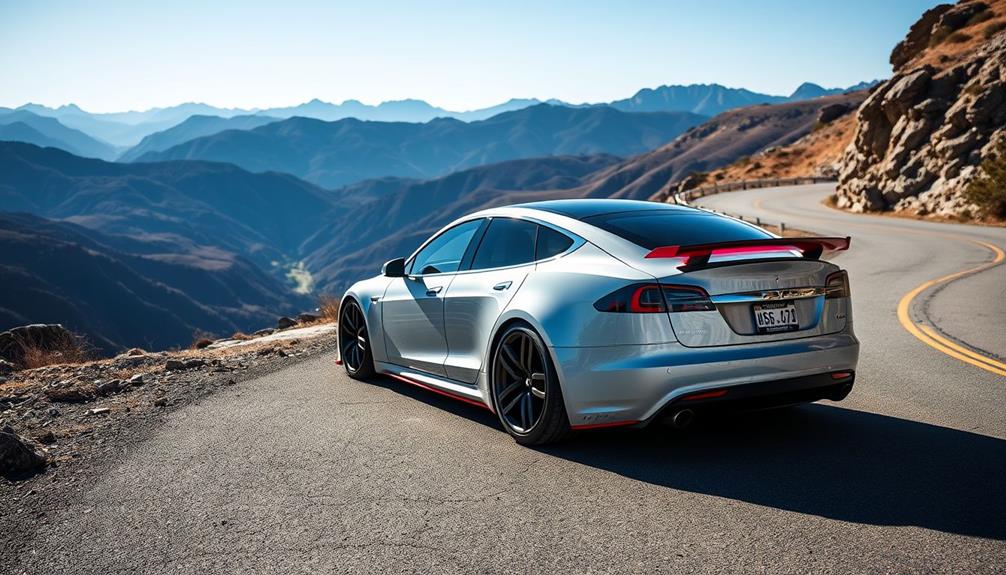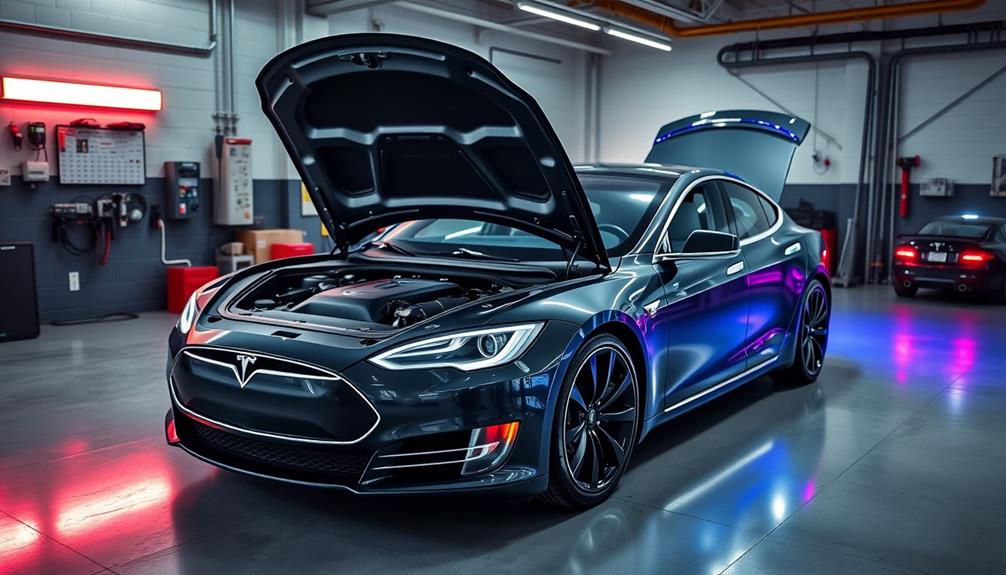Tuning your Tesla Model S releases an unbeatable blend of luxury and performance. With modifications like upgraded cooling systems and optimized gearing, you can boost acceleration and enhance throttle response. Tailoring your settings to local driving preferences can further elevate your experience, whether you seek rapid acceleration or higher top speeds. Engage with the vibrant Tesla community for insights and support on best practices. By fine-tuning power delivery and taking advantage of advanced driving modes, you'll redefine what your luxury EV can do. Keep exploring, and you'll discover even more ways to maximize your Model S's performance potential. Explore aftermarket upgrades and performance packages to take your Tesla Model S to the next level. By investing in high-quality components and working with experienced technicians, you can unlock even more power and agility from your electric vehicle. Remember, the journey to maximizing your electric vehicle’s potential is ongoing, so stay curious and open to new possibilities in the world of EV customization and tuning.
Key Takeaways
- Upgrading the cooling system with larger radiators and high-flow pumps enhances performance and prevents overheating during intense driving sessions.
- Optimizing gear ratios, such as implementing an 11.39:1 final gear ratio, significantly boosts acceleration and torque management.
- Advanced throttle pedal input interception improves throttle response, enhancing acceleration without compromising torque mapping.
- Tailoring performance to regional preferences, such as acceleration for U.S. drivers and top speed for Europeans, enhances the driving experience.
- Engaging with the Tesla Motors Club community provides valuable insights and support for performance upgrades and tuning challenges.
Tuning Challenges and Solutions
Tuning a Tesla Model S presents several unique challenges that can frustrate even the most skilled enthusiasts. One considerable hurdle is the complexity of firmware updates, which involve cryptographic checksums and RSA encryption. These measures make unauthorized modifications incredibly difficult, meaning you'll need advanced hacking skills to bypass Tesla's firmware validation.
Unfortunately, many attempts to access unencrypted firmware have been unsuccessful due to limited expertise outside the company.
Another critical aspect to take into account is the torque demand mapping table, which is essential for precise power adjustments. However, the fail-safes in the inverter firmware cap maximum torque output to prevent damage, posing additional tuning challenges.
While modifications to the throttle pedal potentiometer inputs can enhance performance, they might conflict with Tesla's existing mapping, requiring careful calibration.
To tackle these issues, you might explore improved cooling systems and driveline components. These upgrades can greatly enhance performance by managing torque more efficiently and improving throttle response.
Enhancing Drivetrain Performance
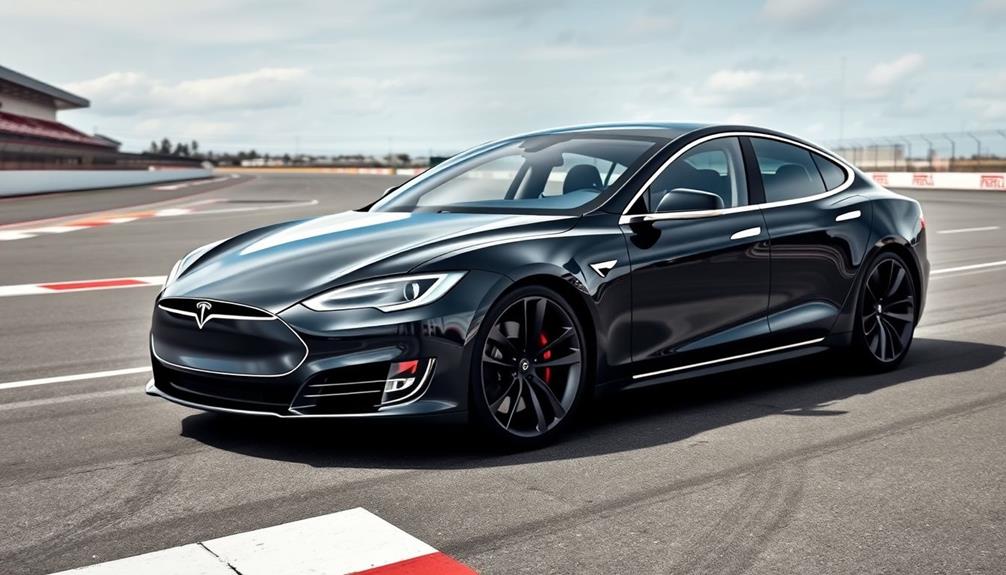
To enhance your Tesla Model S's drivetrain performance, consider intercepting throttle pedal inputs for quicker throttle response.
Upgrading to a high-efficiency cooling system can help manage heat during intense driving, while optimizing your gearing can greatly boost acceleration.
Each of these strategies plays an essential role in maximizing your vehicle's capabilities.
Throttle Input Interception Techniques
Throttle input interception techniques can substantially boost your Tesla Model S's drivetrain performance, but they require careful consideration. By intercepting throttle pedal potentiometer inputs, you can enhance power delivery, yet this might conflict with Tesla's existing torque demand mapping and fail-safes in the inverter firmware.
Understanding the torque demand mapping is essential for modifying throttle inputs effectively without exceeding system limits. Any adjustments need to be approached cautiously to avoid unintended consequences that could negatively impact vehicle responsiveness and performance.
To help you grasp the implications of throttle input interception, here's a quick overview:
| Technique | Benefits | Considerations |
|---|---|---|
| Basic Interception | Increased acceleration | May affect torque mapping |
| Advanced Interception | Enhanced throttle response | Requires technical expertise |
| Combined with Upgrades | Improved overall performance | Possible firmware conflicts |
Enhanced driveline components can complement your efforts by improving torque management efficiency. Remember, tuning involving throttle input interception demands advanced skills, given Tesla's complex firmware protections and cryptographic checksums. Proceed with care for ideal results!
Cooling System Upgrades
When it comes to enhancing the drivetrain performance of your Tesla Model S, upgrading the cooling system is vital. Without effective cooling, even the most high-performance setups can struggle under pressure.
By investing in cooling system upgrades, you can guarantee your vehicle remains at peak performance during intense driving conditions. Here are three significant upgrades to take into account:
- Larger Volume Radiator: A bigger radiator boosts cooling efficiency, preventing overheating and supporting those high-performance applications you crave.
- High-Flow Water Pumps: These pumps maintain consistent temperatures in your drivetrain, especially important during extended high-performance sessions or racing.
- Enhanced Cooling Fans: Upsampled fans improve airflow, effectively managing heat dissipation and sustaining performance under stress.
Implementing these cooling upgrades not only enhances your Tesla's performance but also increases the longevity of its drivetrain components.
Gearing Optimization Strategies
Upgrading your Tesla Model S's cooling system sets the stage for even more performance enhancements, particularly through gearing adjustment strategies. By implementing an 11.39:1 final gear ratio, you can greatly boost acceleration at higher speeds while enhancing overall drivetrain performance.
To maximize power output without triggering fail-safes in the inverter firmware, it is crucial to modify the torque demand mapping table. This adjustment enhances torque management, ensuring that you get the best throttle response and acceleration without compromising safety.
Here's a quick overview of how different gear ratios can affect performance:
| Gear Ratio | 0-60 Performance | Top Speed | Torque Management |
|---|---|---|---|
| 9.73:1 | Excellent | Moderate | Standard |
| 10.00:1 | Good | Good | Improved |
| 11.39:1 | Moderate | Excellent | Enhanced |
| 12.00:1 | Fair | Very High | Ideal |
Market-Specific Performance Adjustments

Performance tuning for the Tesla Model S embodies a tailored experience that resonates with regional driving preferences.
When you take into account the unique demands of your location, you can markedly enhance your driving experience through market-specific performance adjustments.
For instance, U.S. drivers often crave rapid acceleration, while European consumers frequently seek higher top speeds for track performance.
Here are three key aspects to take into account for your Tesla Model S tuning:
- Acceleration vs. Top Speed: Find the right balance that suits your local driving style and regulations.
- Handling Characteristics: Tailor the suspension settings to match your region's road conditions, enhancing comfort and performance.
- Power Delivery Optimization: Adjust the power curve to meet the specific expectations of your market, ensuring you get the most out of every drive.
Upgrading Cooling Systems

Enhancing your Tesla Model S's cooling system can take your driving experience to the next level, especially after fine-tuning its performance for local conditions. Upgrading the cooling system is essential for maintaining consistent temperatures during high-stress operations, preventing overheating and ensuring ideal power delivery.
Start by installing a larger volume radiator and a high-flow water pump. These components improve airflow and cooling efficiency, allowing your vehicle to sustain performance even during demanding driving conditions.
Additionally, implementing upsampled cooling fans can considerably boost the system's effectiveness, providing better heat management for the drivetrain during intense performance scenarios.
When you're pushing your Model S to its limits, managing increased current draw and heat generation is critical. Without proper cooling, performance can degrade, leading to potential issues.
For those seeking even more advanced solutions, consider utilizing liquid nitrogen (LN2). This method offers superior thermal management benefits, especially in high-performance applications where traditional cooling might fall short.
Engaging With the Tesla Community

Engaging with the Tesla community can greatly enrich your ownership experience. By connecting with other enthusiasts, you gain valuable insights and foster a sense of camaraderie that enhances your journey with electric vehicles.
The Tesla Motors Club (TMC) is a fantastic platform for sharing knowledge on tuning and performance upgrades. Here are three reasons to get involved:
- Collaborative Learning: You'll find others sharing their experiences with aftermarket performance upgrades, helping you make informed choices for your Tesla.
- Innovative Solutions: The collective expertise within the community often leads to creative fixes for common challenges, like heat management during high-performance driving.
- Technical Insights: Active members discuss essential technical details, such as temperature limits and PID settings, to help optimize your vehicle's performance.
Performance Specifications Overview
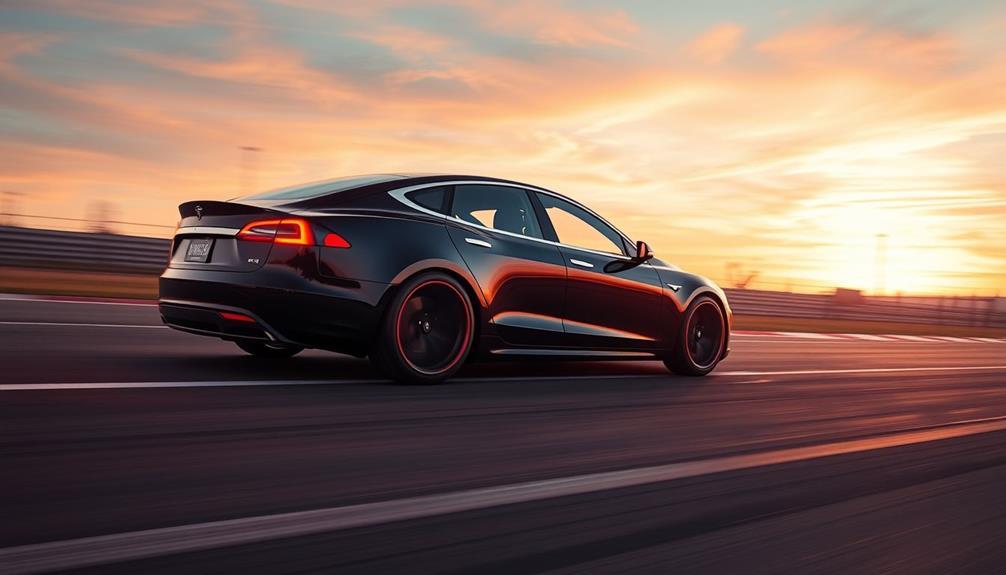
When it comes to the Tesla Model S, the numbers speak volumes about its capabilities. With an astonishing output of 1,020 horsepower and a torque rating of 1,420 Nm, this luxury EV is engineered to deliver exceptional performance specifications.
You'll experience mind-blowing acceleration, as the Model S can rocket from 0-60 mph in just 1.99 seconds, making it one of the fastest electric sedans on the market.
The Model S also offers a higher top speed of 200 mph, ensuring that it competes fiercely with high-performance vehicles in any setting. Its versatility shines through various driving modes; in Sport mode, you can still achieve 0-60 mph in just 2.7 seconds, while Chill mode gives you a more relaxed ride, taking 7.3 seconds but maximizing range.
Don't forget the cutting-edge drag strip mode, which activates a "cheetah stance" to optimize torque delivery for peak performance during acceleration.
Whether you desire blistering speed or practical efficiency, the Tesla Model S delivers an unparalleled driving experience that caters to your needs.
Driving Modes and Features
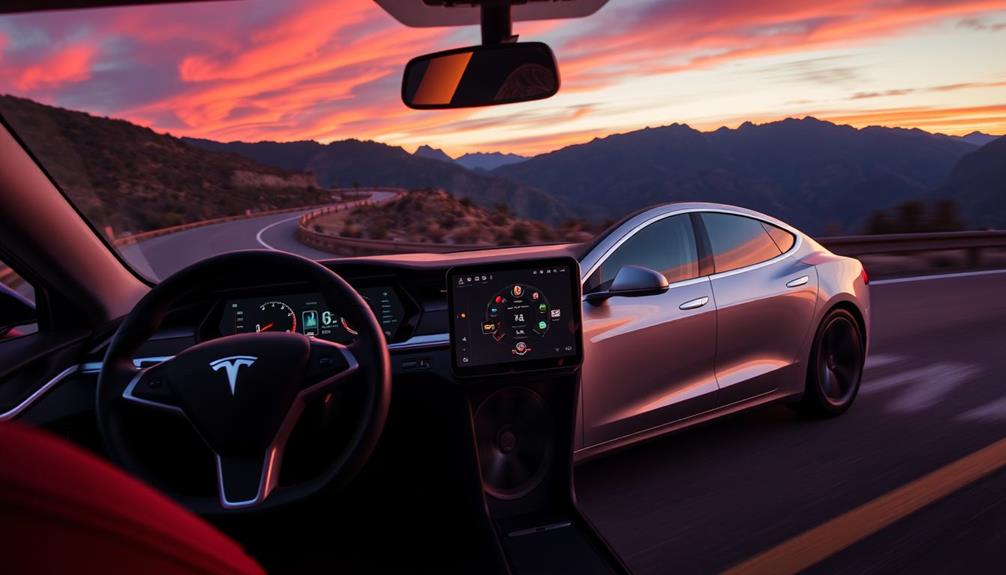
The Tesla Model S offers a range of driving modes designed to enhance your driving experience, whether you're on a racetrack or cruising through the city. Each mode tailors performance to fit your needs, ensuring you get the most out of your luxury EV.
- Drag Strip Mode: Experience the thrill of acceleration with a "cheetah stance" that optimizes torque delivery, allowing you to launch with incredible speed.
- Track Mode: This mode fine-tunes your handling balance, stability assist, and braking, giving you the confidence to push the limits on the track.
- Sport Mode: Feel the rush as you hit 0-60 mph in just 2.7 seconds, showcasing the Model S's high power and performance capabilities.
For those times when you're looking for a more relaxed drive, the "Chill Mode" slows acceleration to 0-60 mph in 7.3 seconds, helping you maximize range without sacrificing comfort.
Plus, with the built-in dash cam, you can review your performance and refine your skills.
With these driving modes, the Tesla Model S truly adapts to your lifestyle and driving preferences.
Design and Comfort Enhancements
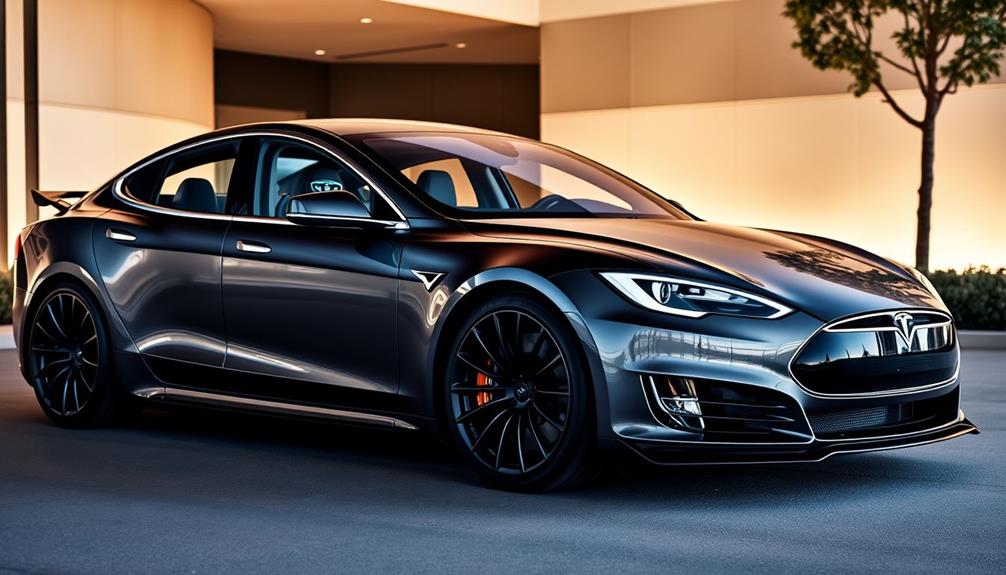
Exceptional design and comfort enhancements in the Tesla Model S create an unparalleled driving experience. The redesigned suspension with a five-link setup markedly improves ride quality, ensuring you glide over rough terrain while enjoying sporty handling. With standardized air springs, your Model S can automatically adjust its ride height based on GPS data, providing enhanced comfort and stability across various conditions.
You can also customize your suspension settings, tailoring the ride characteristics to your preferred driving style and specific locations. This personal touch makes each journey uniquely enjoyable. The interior designs are trademarks of luxury, emphasizing comfort without compromising on performance.
Here's how these enhancements compare:
| Feature | Impact on Experience | Key Benefit |
|---|---|---|
| Five-link suspension | Improved ride quality | Smooth handling on rough terrain |
| Automatic ride height | Enhanced stability | Adapts to driving conditions |
| Customizable settings | Personalized driving experience | Tailored to your preferences |
| Luxurious interior | Ultimate comfort | High-end feel |
| Advanced tech features | Seamless functionality | Tracks performance effortlessly |
With these enhancements, the Tesla Model S truly redefines what a luxury EV can be.
Frequently Asked Questions
Can Tesla Performance Be Upgraded?
Yes, you can upgrade Tesla's performance through aftermarket modifications. You'll find options like suspension kits and wheel upgrades that enhance driving experience, plus tuning techniques that optimize acceleration and power output for your specific needs.
How Do I Change My Tesla to Creep Mode?
Think of your Tesla as a graceful dancer. To switch to Creep Mode, tap the "Controls" menu on your touchscreen, select "Driving," and toggle "Creep" to "On." It'll glide effortlessly in tight spaces.
Can You Tune a Tesla to Make It Faster?
Yes, you can tune your Tesla for increased speed. However, it involves advanced modifications and understanding firmware limitations. You'll need to take into account cooling systems and torque adjustments for ideal performance without overheating issues.
What Is an Unplugged Performance?
Unplugged Performance specializes in premium upgrades for Tesla vehicles. You'll find enhancements that improve both performance and aesthetics, ensuring your driving experience is elevated. Their in-house engineering guarantees high-quality products tailored specifically for your needs.
Conclusion
Just like a master sculptor chisels away at marble to reveal a stunning statue, tuning your Tesla Model S uncovers its true potential. By fine-tuning performance and enhancing comfort, you're not just upgrading a vehicle; you're crafting a masterpiece of engineering and luxury. Embrace the journey, engage with fellow enthusiasts, and transform your ride into a unique expression of power and elegance. With every adjustment, you create a symphony, harmonizing speed, comfort, and innovation.
